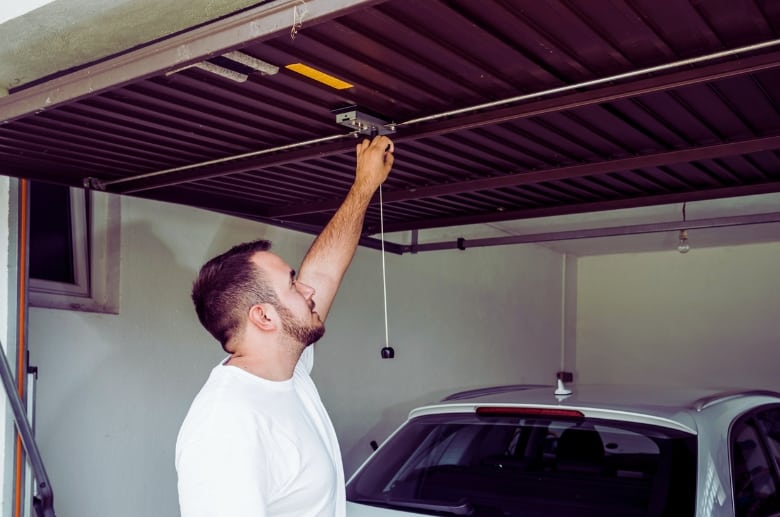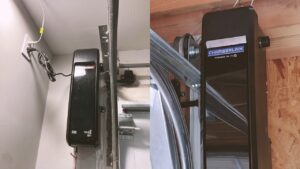Garage door to entry door conversions are becoming increasingly popular among homeowners seeking innovative ways to maximize their space. This transformation can offer a dual-purpose solution, serving as a functional entry point and adding aesthetic appeal to your home’s exterior.
However, it’s not a simple DIY task—it requires careful planning, a basic understanding of construction principles, and a keen attention to detail. Whether considering this change for convenience, increased property value, or to meet changing family needs, a thorough understanding of the conversion process is crucial.
Let’s jump into this transformative journey and guide you through how to convert garage door to entry door.
Is It Possible to Convert My Garage Door to an Entry Door?
It’s possible to convert your garage door into an entry door. With the correct tools, instructions, and execution, converting your garage door can be fairly simple. However, the process has certain concerns that must be considered before proceeding.
Connect With A Garage Expert
Connect with local experts, Compare quotes, Get the best price.
What Are the Concerns When Converting My Garage Door to an Entry Door?
When converting your garage door into an entry door, it is important to consider the following key factors carefully:
- Process: Converting a garage door to an entry door involves removing the garage door and its hardware, framing a new opening for the entry door, and installing the new door. It also involves ensuring proper insulation, weatherproofing, and electrical work if you want to add lighting or security features.
- Safety and Security: Ensure the new entry door meets safety standards and provides proper insulation and protection against weather elements.
- Difficulty: The difficulty level for this conversion can vary depending on factors like the garage door type, your skill level, and the structural considerations of your garage.
Connect With A Garage Expert
Connect with local experts, Compare quotes, Get the best price.
Pros and Cons of Garage Door-to-Entry Door Conversion
Converting your garage door to an entry door has advantages and disadvantages.
Pros:
- Improved functionality: By replacing the garage door with an entry door, you can transform the area into additional living space or extend it as a functional part of your home.
- Aesthetics: A conversion would be useful aesthetically, particularly if your garage door needs to be updated or match the architectural style.
- Increased Energy Efficiency: Converting the door into an energy-efficient door can improve energy efficiency in your home by reducing drafts and heat loss from the garage.
- Increased Home Value: A properly executed conversion can increase the value of your home, particularly if the converted space adds usable square footage.
Cons:
- Cost: This remodelling project involves high costs, including purchasing a new door, framing, insulation, and potential electrical work.
- Structural Modifications: Converting a garage door to an entry door may require structural modifications, which could be challenging and affect your garage’s integrity if not done correctly.
- Limited Garage Functionality: Once converted, you will lose the convenience of using the garage for parking vehicles, storage, or other garage-specific activities.
- Potential Maintenance: Entry doors may require more maintenance than garage doors, including regular cleaning, painting, and weatherproofing to ensure longevity.
What To Consider Before Converting a Garage Door To An Entry Door?
Converting your garage door to an entry door requires the correct steps and procedure to succeed. Below are some effective steps to help you with your conversion:
1. Inspecting the Garage Space

Inspecting the garage space to confirm that it meets your needs and requirements is essential. Here are two key aspects to consider:
- Size compatibility: Measure the garage opening, wall space, and floor area to ensure they are compatible with the size and style of the new entry door. The dimensions should allow for proper installation and functionality without obstructions or limitations.
- Safety considerations: Check for hazards like exposed electrical wires, uneven flooring, or structural issues. Ensure there are no issues with ventilation, pest infestations, or water leaks that could impact the integrity of the entry door or compromise the safety and comfort of the converted space.
2. Legal and Building Code Considerations
Understanding the legal aspects and building codes related to this type of renovation is crucial. Here’s why:
- Compliance with Regulations: By checking and adhering to these codes, you ensure that your conversion meets the necessary safety and quality standards set by the authorities.
- Avoiding Penalties and Legal Issues: Obtaining the required permits and following the prescribed guidelines ensures that your conversion is conducted within the legal framework.
- Safety and Structural Integrity: Following Building codes helps ensure that your converted entry door meets safety standards and provides a secure and stable structure.
- Insurance Coverage: If your conversion does not meet the required codes, it could invalidate your coverage.
3. Selecting an Entry Door

Here are different design options to consider and tips on how to choose a design that complements your house’s style and curb appeal:
- French Doors: These doors feature multiple glass panels that provide a classic and elegant look. They are ideal for homes with a traditional or vintage architectural style.
- Sliding Glass Door: This type is popular for contemporary and minimalist home styles. It offers a modern and sleek design, provides an expansive view, and allows natural light to fill the space.
- Barn Door: Barn doors offer a rustic and unique design. They are made from wood, metal, or glass and normally slide on a track. Barn doors are suitable for farmhouse-style or industrial-themed homes, adding a touch of charm and character to the entryway.
- UPVC Door: UPVC doors have many benefits, including durability, low maintenance, and energy efficiency. They are also available in various styles and can mimic the appearance of wood or other materials.
- Solid Doors: As the name suggests, solid doors are made from durable materials like wood, fibreglass, or metal and offer a classic and substantial look.
With the types of doors aside, here are tips on how to choose a design that complements the house’s style and curb appeal:
- Consider the Architectural Style: Select a door design that aligns with the overall aesthetic and enhances the architectural elements of your home.
- Coordinate with the Color Scheme: Choose a door color that complements or contrasts with the exterior color palette of your home. Also, consider the existing trim, siding, or brickwork to create a cohesive and visually appealing look.
- Balance Between Uniqueness and Conformity: While selecting a design that stands out and adds character to your home is crucial, ensure that it also blends with the surrounding neighborhood and maintains a sense of cohesion.
- Seek Professional Assistance: Consult with architects, designers, or door specialists for guidance on selecting a door design that suits your house’s insulation, weatherproofing, and style needs.
Connect With A Garage Expert
Connect with local experts, Compare quotes, Get the best price.
4. Estimate the Cost
The correct cost estimation allows you to assess the project’s financial feasibility and determine if it aligns with your budget. It also helps you decide whether to proceed with the conversion or explore alternative options.
You can expect to pay between $800 and $3,000 for a garage door conversion project. However, this cost will vary depending on the following factors:
1. Materials
You can pay around $700 to $1,200 for your entry door. However, the cost of the entry door itself will vary depending on the material chosen, the quality, and additional features.
The frame and hardware will cost between $250 and $600, but this range will vary depending on the frame’s material, the complexity of the hardware required, and specific customization options.
2. Labor
For experienced DIYers, the labor cost of converting a garage door to an entry door can be significantly reduced or even eliminated.
On the other hand, hiring a professional will cost you between $420 to $1,600, depending on the complexity of the project and the hourly rates of the professionals in your area.
3. Additional Modifications
If you choose to add insulation or enhance the weatherproofing of the entry door, you’ll expect to part ways with around $600 to 1,300. Electrical work, like lighting, security features, or other electrical components, will cost you around $400 to $600.
To help you save you some bucks on this project, here are top budgeting tips to ensure your DIY project is a success:
- Consider additional expenses, such as permits or potential unforeseen costs, and allocate funds accordingly.
- Contact multiple professionals and request comprehensive quotes for the conversion project. Once you have the quotes, compare them to find the best fit.
- Invest in durable and secure materials to ensure long-term satisfaction and reduce the need for repairs or replacements in the future.
- Set aside a contingency fund to account for any unexpected expenses or changes during the project.
Connect With A Garage Expert
Connect with local experts, Compare quotes, Get the best price.
How To Convert Garage Door To Entry Door Step-by-Step Guide
The long-awaited moment is finally here—converting your garage door to an entry door! Below, we highlight the step-by-step details.
Gather the Necessary Tools and Materials

The following tools are necessary for this project:
- Entry door
- Frame
- Hardware (hinges, doorknobs, locks, and handles).
- Paint (suitable for exterior use).
- Sealant and Weatherstripping
- Measuring tape
- Circular saw
- Drill
- Level
- Screwdriver
- Paintbrushes
Consider the following tips to help you choose the appropriate materials:
- If you live in a region with extreme weather conditions, such as high heat or heavy rainfall, choose weather-resistant materials that can withstand the elements. Look for doors and frames made of durable materials like steel or fibreglass, which offer good insulation and can resist warping, rotting, or corrosion.
- Opt for solid, sturdy doors protecting your garage against potential break-ins. Also, select high-quality locks, deadbolts, and hinges to further reinforce your entry door’s security.
- Consider the architectural style of your property and choose materials that align with your personal style preferences.
With the basics aside, here is a step-by-step guide on how to convert garage door to entry door.
Step 1. Remove the Garage Door
The first step involves removing the garage door from its frame. However, you’ll need to do this safely to prevent potential accidents or damaging the garage door. Here are the steps on how to do it safely:
- Disconnect the Power: Disconnecting the power supply eliminates the risk of electrical shock or accidental garage door opener activation.
- Release the Tension on the Springs: If your garage door has extension springs, use the appropriate tools to release the tension. If it has torsion springs, we recommend you seek assistance from a professional, as they can be dangerous due to their high tension.
- Remove the Garage Door Panels: Starting from the top panel, carefully remove each panel by unscrewing them from the track. Ensure you have someone to assist you in holding the panels to prevent them from falling.
- Detach the garage door tracks: Unscrew the brackets securing the tracks to the wall and ceiling. Remove the tracks one section at a time, starting from the top and working your way down.
If you plan to reuse the garage door opener and motor, handling them carefully is crucial. Here are tips for doing so:
- Carefully read and follow the manufacturer’s instructions for your model to ensure a safe and effective disconnection process.
- If you lack experience working with electrical components, seek help from a professional.
- Label each wire before disconnecting it from the opener and motor to ensure correct reconnection later. Taking pictures or drawing a diagram can also be helpful for reference.
- After disconnecting the two components, place them in safe and secure areas, free from any potential damage or interference.
Step 2. Preparing the Opening
The opening preparation involves framing the garage opening and levelling using shims. Here’s how to do it:
- Measure and Mark: Measure the dimensions of the new entry door accurately and mark the corresponding measurements on the garage opening.
- Remove Obstructions: Clear the opening of obstructions, like debris, nails, or protruding objects, that may hinder the installation process.
- Install the Door Frame: Install the door frame according to the manufacturer’s instructions. Use marked measurements as a guide, and ensure the frame is square and level.
- Use Shims for Leveling: Place shims between the door frame and the rough opening where necessary to adjust for unevenness in the garage opening.
- Secure the Door Frame: Use appropriate screws or nails to secure the frame to the surrounding structure once properly leveled and aligned. Ensure you also follow the manufacturer’s recommendations for fastening the frame securely.
To use the shims effectively, here are some tips to help you out:
- Check the levelness and plumpness at various points along the frame to ensure an even fit.
- Use a quality construction adhesive between the door frame and the rough opening to add stability and reduce potential air leaks.
- Double-check the measurements and ensure the frame is square before securing it. This will help prevent any issues with door operation or alignment later on.
Step 3. Installing the Entry Door
Here’s how to install the new frame and doorway, followed by detailed steps on door installation:
- Install the New Frame: Carefully place the new door frame into the prepared opening. Use shims to ensure an even gap between the frame and the rough opening. Secure the frame to the surrounding structure using appropriate screws or nails.
- Attach the Hinges: Position the door on the hinges provided with the doorframe. Follow the manufacturer’s instructions for proper hinge installation. Use a level to ensure the door is upright, and adjust the hinges if necessary.
- Install the Knob or Lever: Attach the knob or lever to the door according to the manufacturer’s instructions. Ensure that it functions smoothly and securely.
- Add a Deadbolt for Security: Follow the manufacturer’s instructions for proper installation, ensuring that the deadbolt aligns with the strike plate on the doorframe.
Moreover, installing additional features can enhance your entry door’s functionality, convenience, and security. The following tips should help you easily install features like a doorbell, peephole, and keyless entry system.
- Carefully read and follow the manufacturer’s instructions for each additional feature to ensure proper installation and functionality.
- Use the tools and hardware the manufacturer recommends to install the features securely.
- Double-check the alignment and positioning of each feature before finalizing the installation to ensure proper operation.
- Test each feature after installation to verify that it functions as intended.
Step 4. Finishing Touches
Now that the entry door is intact, it’s time for the finishing touches to ensure proper sealing, protection, and aesthetic appeal. Here are simple steps to do this:
- Seal the Door with Weatherstripping: Cut weatherstripping to the appropriate length and attach it to the door frame, ensuring a snug fit that seals gaps. This will help maintain insulation and prevent air leakage.
- Apply a Protective Coat of Paint: Choose a high-quality exterior paint suitable for your entry door material, and apply a protective coat according to the manufacturer’s instructions.
- Add Motion Sensor Light: You can install a motion sensor light near the entry door for convenience and security. Follow the manufacturer’s instructions for proper installation, positioning, and adjusting the settings.
- Add Decorative Hardware: Select the hardware that complements the style of your door and overall design scheme. These items include handles, knobs, kickplates, or door knockers.
Converting Garage Door to an Entry Door: Hiring Professionals vs. DIY
It’s crucial to thoroughly evaluate the pros and cons of choosing between hiring professionals and the DIY way for the best results.
Pros of Hiring Professionals

Here are the benefits of seeking professional help:
- Expertise and Experience: Professional contractors have the knowledge, skills, and experience to handle garage door conversions efficiently and effectively. They are well-versed in local building codes, safety protocols, and industry best practices, ensuring a high-quality result.
- Time and Convenience: Professionals have the tools, equipment, and resources to complete the project efficiently, allowing you to focus on other tasks. They also handle permits, inspections, and other necessary paperwork, streamlining the process.
- Quality Workmanship: Professionals take pride in their work and strive for excellence. They have access to high-quality materials and ensure proper installation, structural integrity, and functionality of your entry door.
- Insurance and Warranty: Reputable professionals often carry liability insurance and offer warranties on their work. This protects in case of accidents, damages, or issues arising during or after the conversion.
Connect With A Garage Expert
Connect with local experts, Compare quotes, Get the best price.
Cons of Hiring Professionals
Here are the disadvantages of hiring professionals for your garage door conversion:
- Cost: Hiring professionals typically involves labor costs that can significantly increase project expenses.
- Less Control and Personalization: Contractors work based on their expertise and the agreed-upon plans, potentially limiting your customization options.
- Scheduling and Availability: Professionals may have scheduling constraints, leading to potential delays in starting or completing the project. This can be inconvenient if you have specific timeframes or deadlines.
Pros of DIY
Here are the benefits of Doing It Yourself:
- Cost Savings: Undertaking the conversion as a DIY project can result in significant cost savings, as labor expenses are eliminated. This allows you to allocate more toward materials and tools, potentially allowing for higher-quality products.
- Personal Satisfaction and Control: DIY projects offer a sense of personal accomplishment and control. You can customize the project to your preferences and choose desired materials and design elements.
- Learning Opportunity: Taking on a DIY project provides an opportunity to learn new skills, gain knowledge about construction and home improvement. This can be fulfilling and valuable for future projects.
Cons of DIY
Here are the limitations of DIY:
- Lack of Expertise and Experience: Garage door conversions involve complex structural modifications, like electrical work, and ensuring proper installation. Inadequate knowledge or skills can lead to safety hazards, subpar results, and costly long-term repairs.
- Time and Effort: DIY projects can be time-consuming, particularly if you are less experienced. The learning curve, research, and trial and error can extend the project timeline for your garage door conversion.
- Potential Mistakes and Risks: Most DIY projects carry the risk of making mistakes that could compromise the safety, functionality, or aesthetics of the converted entry door. Poorly executed work may require professional intervention to rectify, adding extra expenses.
Maximizing the Value of Your Garage Conversion
The following are some fantastic ideas to elevate the functionality of your garage space and maximize the value of your garage conversion.
- Create a Workshop: Set up a well-equipped workshop with workbenches, tool storage, and proper lighting. A dedicated space for DIY projects or hobbies can be exciting if you enjoy tinkering or creating.
- Convert Into Storage Area: Maximize the garage’s storage potential by installing shelves, cabinets, and overhead racks.
- Additional Living Space: Turn the garage into a living area like a home office, gym, or playroom.
Final Thoughts
Converting a garage door to an entry door requires careful planning, consideration of building codes, and understanding the necessary steps. You should also weigh the pros and cons of DIY versus hiring professionals.
If in doubt or lack the required expertise, seek the assistance of a professional to ensure a safe and well-executed conversion.
FAQs
How Much Does It Cost to Replace a Garage Door With French Doors?
Generally, replacing your garage door with French doors range from $1,600 to over $3,000. However, this cost varies depending on factors such as the doors’ quality, the opening’s size, and additional modifications required.
Do You Need a Building Permit To Remove The Garage Door?
The need for a building permit to remove a garage door may vary depending on local building codes and regulations. If the removal involves structural modifications or affects the overall integrity of the building, a permit may be required.
However, when the removal is straightforward and doesn’t involve significant changes to the structure, a permit may not be necessary.
Is Replacing a Garage Door Worth It?
Replacing a garage door can be worthwhile, particularly if you no longer require the garage space. By repurposing the area into a functional living space, such as a home office, gym, or additional living area, you can maximize the use of your property and tailor it to your specific needs.




